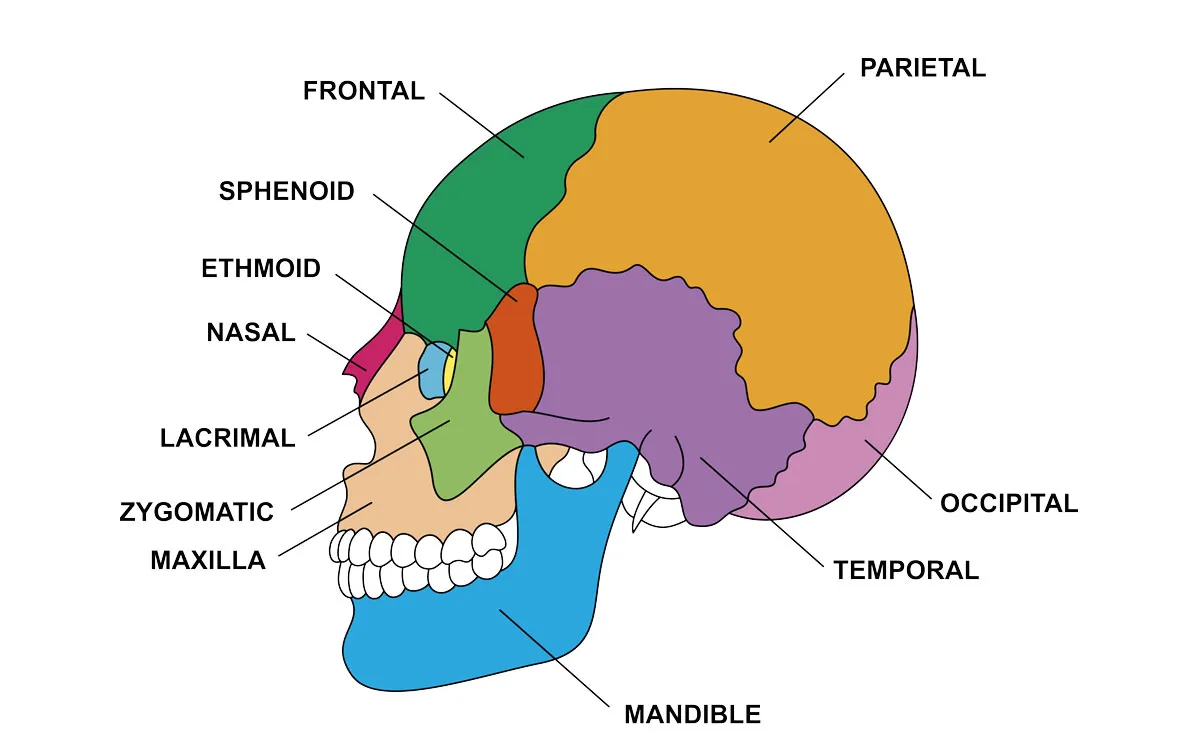The human body has 206 bones in total, though it’s possible for some adults to have more. This is because the number of bones in our ribs, vertebrae and digits can vary from person to person, and so you can have up to 213 bones.
The skeletal system is broadly split into two different sections; the axial skeleton and the appendicular skeleton. The axial skeleton is made up of 80 bones that support our upper body, while the appendicular skeleton consists of the 126 bones in our limbs and pelvis.
Bones give the human body shape, support and protection, and help us do all of the things we do each day.
Key parts of the human skeleton
Skull
The human skull, or cranium, gives our head its structure and protects our all-important brain. Made up of facial bones and the brain case, our skulls contain 22 individual bones.

Spine
The spine is made up of 24 small bones called vertebrae. It keeps us upright, supports movement and protects our spinal cord – the column of nerves that connects our brain to the rest of the body.
Ribs
Ribs are the long curved bones that make up our ribcage. They protect our lungs and heart, provide support and help with breathing.
Arm bones
Each arm has a humerus in the upper arm and a radius and ulna in the forearm.
Pelvis
The pelvis is found in the central part of the skeleton. These bones play a critical role in supporting the skeleton and movement, as well as protecting organs.
Leg bones
Each leg is supported by a femur (thigh bone), patella (kneecap), tibia (shin bone) and fibula (calf bone).
Hands and Feet
Our hands and feet contain many different small bones. The fingers and toes alone have 56 bones in total called phalanges.
Types of bone
Bones vary greatly depending on their placement and role in the body. A bone classification system separates them into different types based on their shape.
- Flat bones. Usually thin, but also curved e.g. the scapulae (shoulder blades).
- Long bones. Cylindrical bones that are longer than they are wide e.g. femurs (thigh bones).
- Short bones. About as long as they are wide, and cube-shaped e.g. carpals (wrist bones)
- Sesamoid bones.Small and round e.g. patellae (kneecaps).
- Irregular bones.A shape that doesn’t fit in the other categories e.g. vertebrae.
What is the biggest bone in the body?
The largest bone in the human body is the femur. It’s also the heaviest and the strongest bone. We have one femur in each thigh to support our weight, help us move and provide other useful functions.
What is the smallest bone in the human body?
The smallest bone in our body is called the stapes. It is one of three tiny and delicate bones in our ear known collectively as the ossicles – the other two being the malleus and the incus. They help with transmitting sound waves to the inner ear.
What are bones made of?
“Bones contain a huge number of minerals, a huge amount of calcium, a good bit of phosphorous and other trace materials as well,” forensic anthropologist Sue Black told BBC Science Focus in 2021
“And that becomes really important, because bones as you grow them and as they mature, are always regenerating themselves.”
According to the US National Institute of Arthritis and Musculoskeletal and Skin Diseases, every bone has a dense, hard outer layer of tissue called compact or cortical bone and a less dense inner layer of tissue called cancellous, trabecular or spongy bone.
What is bone marrow?
Bone marrow is a soft tissue found at the centre of bones in the medullary cavities. It creates stem cells that in turn, become blood cells.
According to the University of California, San Francisco Benioff Children's Hospital, bone marrow makes red blood cells to transport oxygen around the body, platelets to help clot blood and stop bleeding, and white blood cells to combat infections.
There are two different types of bone marrow called red marrow and yellow marrow. All of the cells are produced in red marrow, while yellow marrow is mostly made up of fat cells and contains stem cells that make fat, cartilage and more bone.
How do you keep bones healthy?
As a general rule, eating a balanced diet will give your bones all of the nutrients they need. Calcium is a famously good mineral for building and maintaining healthy bones.
Dairy products such as milk and cheese are good sources of calcium, though they don’t agree with everyone! Other sources include leafy vegetables, beans and seeds.
Bones also need vitamin D to help your body absorb calcium. Most of our vitamin D needs come from the sun shining on our skin, though the NHS recommends everyone should consider taking a vitamin D supplement in the autumn and winter.
The NHS also notes that some research suggests that too much vitamin A may increase your chances of bone fractures. One food with a high concentration of vitamin A is liver, and so people frequently chow down on liver are advised to only have it once a week.
Supplements containing retinol, which is a form of vitamin A, are also not advised.
Bone fun facts
- Babies are born with more than 300 bones, but they fuse as we age, and that’s why adults only have between 206 and 2013.
- Bones aren’t dead, dry things but living tissues that slowly replenish and replace themselves like our skin does.
- Human bones are identical in form and function to many other mammals. The bones in your hand have the same layout as a bat’s wing!
Read more:
